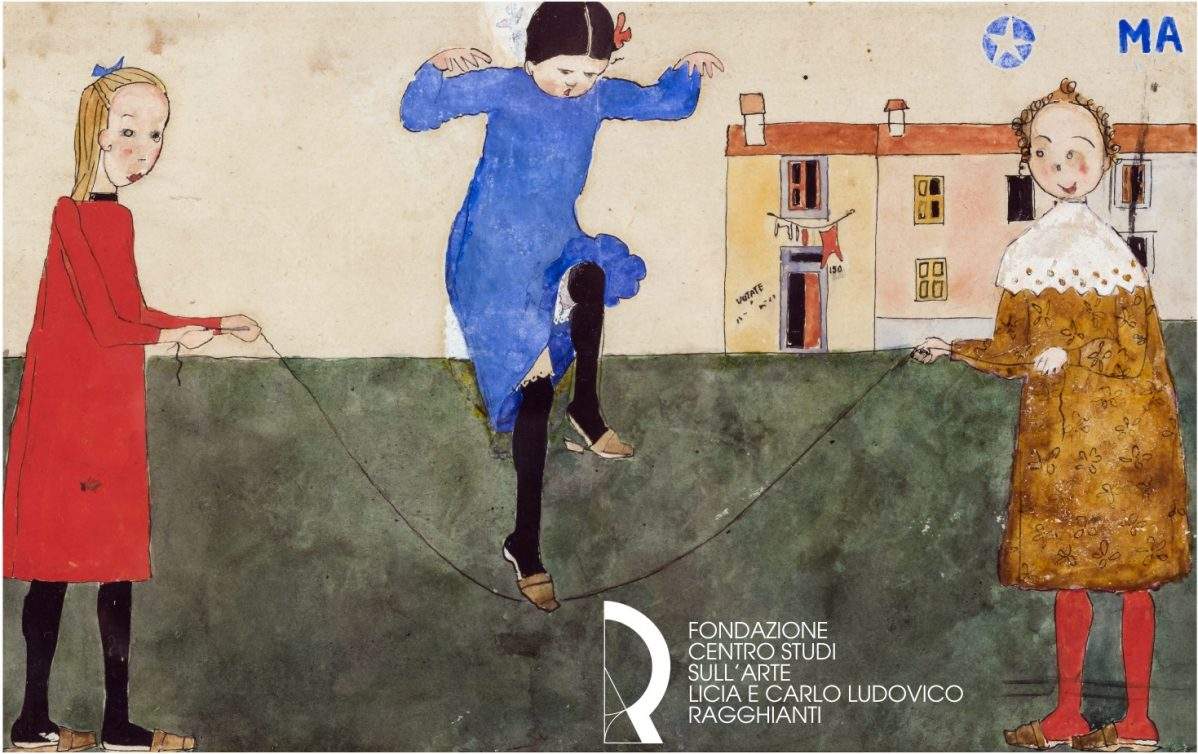The Child Artist. Childhoodand Primitivism in Early Twentieth-Century Italian Art: this is the title of the exhibition that the Ragghianti Foundation is hosting at its headquarters in Lucca, in the monumental complex of San Micheletto, from March 17 to June 2, 2019. In 1969, the great scholar Carlo Ludovico Ragghianti pointed out the need to investigate the link between child drawing, medieval art and the figurative production of the first three decades of the twentieth century, a topic of which Ragghianti himself had been a pioneering investigator in his essay Bologna cruciale 1914, a text that would prove fundamental for future research on twentieth-century Italian art. Ragghianti, after stressing the importance for the study of children’s drawing of Corrado Ricci’s famous essay L’arte dei bambini (Bologna, 1887), listed what the main stages of interest in children’s art were: Tolstoy’s Jasnaja Poljana school on spontaneous drawing of children, founded in 1861; Giovanni Ferretti’s volume Aesthetic Education (1909); the exhibition of children’s painting opened at the Paris Youth Salon in 1908; and again the Italian contributions to theInternational Exhibition of Drawing Didactics (Dresden, 1912) and the Das Kind und die Schule pavilion (Leipzig, 1914).
Ragghianti concluded his study by admitting the incompleteness of his own investigation: that is, further investigation was needed. The exhibition, curated by Nadia Marchioni, intends precisely to fill this gap: the theme is addressed with an in-depth investigation of its antecedents and developments. The examples of “regression” toward childlike drawing by Italian artists between the second and third decades of the 20th century documented by Ragghianti in his essay recounted, among others, the experiences of Alberto Magri, Ottone Rosai, Tullio Garbari, Gigiotti Zanini, Carlo Carrà, Riccardo Francalancia and Alberto Salietti. But even earlier, the artists’ attentions to childhood and its graphic expressions find an important antecedent in the work of Adriano Cecioni, as well as in Vittorio Matteo Corcos’ Portrait of Yorick, linked to a poster for Corrado Ricci’s Florentine conference on The Art of Children in 1885, and in Giacomo Balla’s unusual painting The Failure. The exhibition examines all these aspects and also explores explicit archaisms drawn from the study of the masters of the thirteenth and fourteenth centuries, with Alberto Magri among the forerunners, accompanied by his “Apuan” friends Lorenzo Viani and Adolfo Balduini.
This significant circle of Tuscan artists arrived at the stylization of childish and medieval derivation well in advance of the critical attestations of Ardengo Soffici (who proved to be a great admirer of Henri Rousseau in La Voce in 1910) and Carlo Carrà(Vita moderna e arte popolare, Parlata su Giotto, Paolo Uccello costruttore), who, between 1914 and 1916, wished in their articles for a return to “pure forms in space,” advising artists who wished to recover, after the explosive Futurist avant-garde, a formal steadfastness, to be inspired by stylistic features drawn from popular, childish and medieval art.
“It is precisely from this nucleus of Tuscan artists,” declares Nadia Marchioni, "that the exhibition starts to reconstruct the history of the regression to the language of childhood in art, which began with Magri and Viani shortly after the middle of the first decade of the twentieth century and spread among a select circle of artists who had the opportunity to confront themselves more or less directly with these formal expressions, thanks also to the contribution of contemporary critical statements ready to endorse the validity of this countercurrent choice: fateful appears the coincidence between the date of the opening of Magri’s exhibition at the Lyceum in Florence (June 2, 1914) and that of the publication in ’Lacerba’ of Carrà’s essay Modern Life and Popular Art (June 1, 1914), in which the author rails against the ’very false idea of being able to artificially create a virginity and a modern sensibility by going to the distant center of Africa,’ extolling works executed ’for simple enjoyment by children, workers, women,’ as the only way to ’observe and assimilate the plastic laws manifested in their primordial purity.’
The exhibition is made possible thanks to the support of the Fondazione Cassa di Risparmio di Lucca and under the patronage of the Region of Tuscany, the Province of Lucca and the City of Lucca. The Child Artist. Childhood and Primitivism in Early 20th Century Italian Art can be visited Tuesday through Sunday from 10 a.m. to 1 p.m. and 3 p.m. to 7 p.m. Closed Mondays. Tickets: full 5 euros, reduced 3 euros (for groups of more than 15, under 18, primary and secondary schoolchildren, students of universities, art academies and conservatories provided with a booklet, teachers, visitors provided with a ticket to the exhibition “Museo della Follia,” visitors provided with a ticket to the Museo Fattori and Museo della Città - Luogo Pio Arte Contemporanea in Livorno). Free for students of Tuscan universities provided with booklet, children up to 6 years old, disabled (and accompanying person), one accompanying person per group, ICOM members, military and law enforcement with badge, tour guides and journalists with badge. All info, including the many educational workshops, can be found on the Ragghianti Foundation website.
 |
| Artists becoming children again: the exhibition on art and childhood in the early 20th century at the Ragghianti Foundation |
Warning: the translation into English of the original Italian article was created using automatic tools. We undertake to review all articles, but we do not guarantee the total absence of inaccuracies in the translation due to the program. You can find the original by clicking on the ITA button. If you find any mistake,please contact us.